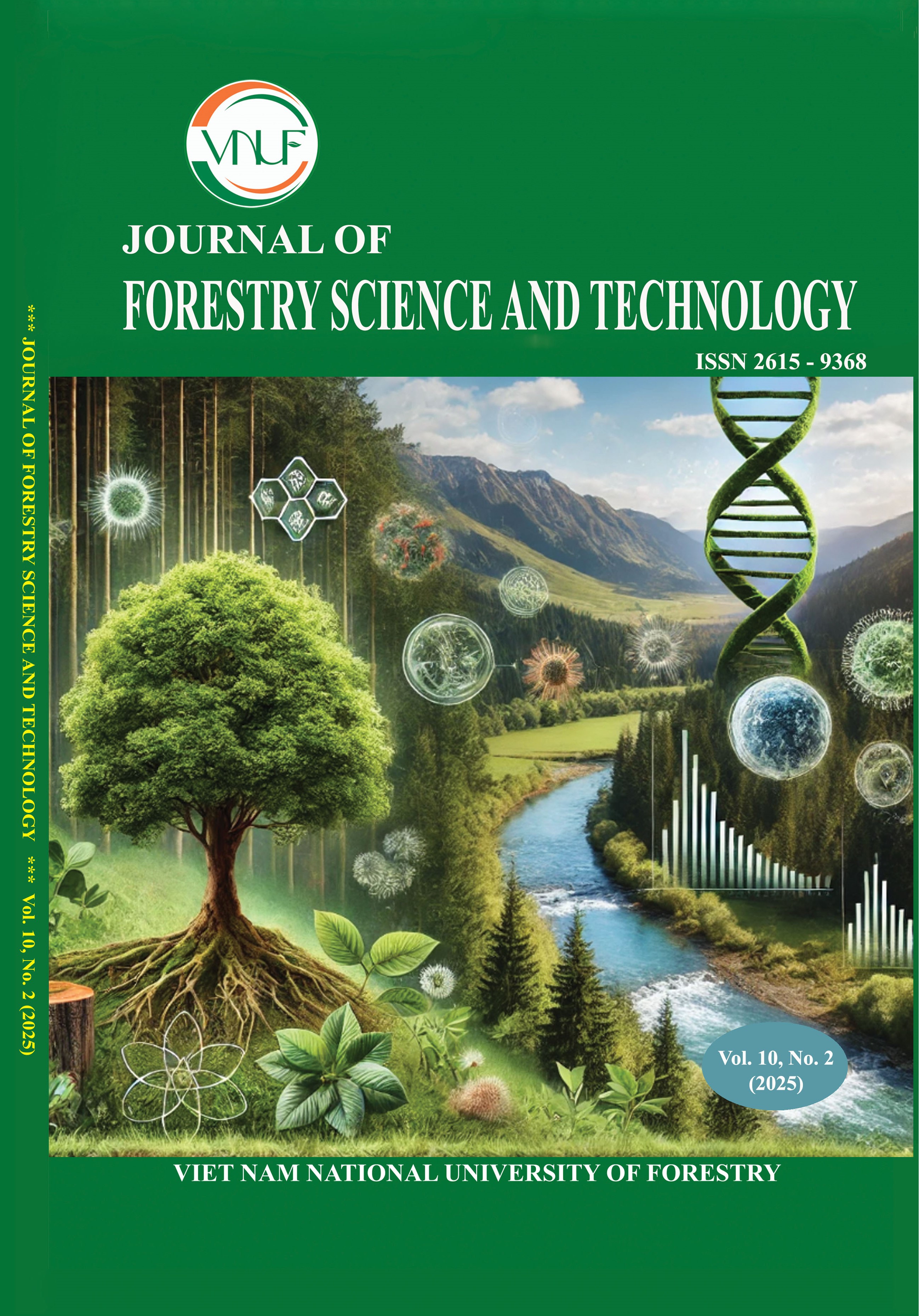Applications of the maximum Entropy model in biodiversity conservation and invasion risk assessment: A case study in Vietnam
DOI:
https://doi.org/10.55250/Jo.vnuf.10.2.2025.031-039Keywords:
Climate change, invasive species, MaxEnt, Pterygoplichthys pardalis, species distribution modellingAbstract
Mô hình Entropy cực đại (MaxEnt), dựa trên nguyên tắc tối đa hóa thông tin trong điều kiện dữ liệu hạn chế, đã được chứng minh là một trong những phương pháp mô hình hóa phân bố loài hiệu quả nhất trong nghiên cứu sinh thái hiện đại. Cách tiếp cận này đặc biệt có giá trị đối với ba ứng dụng chính: (1) đánh giá rủi ro xâm lấn của các loài ngoại lai bằng cách dự đoán các khu vực có điều kiện sinh thái phù hợp, (2) xác định môi trường sống tối ưu cho các loài có giá trị bảo tồn cao hoặc tầm quan trọng về kinh tế và (3) dự báo sự thay đổi phạm vi dưới tác động của biến đổi khí hậu. Trong nghiên cứu điển hình về cá trê miệng mút (Pterygoplichthys pardalis) ở Việt Nam, mô hình MaxEnt đạt độ chính xác dự đoán cao (AUC = 0,916), với lượng mưa của quý ấm nhất (bio18) và phạm vi nhiệt độ trung bình trong ngày (bio2) được xác định là các biến môi trường có ảnh hưởng nhất. Tuy nhiên, phương pháp này có những hạn chế đáng kể, bao gồm yêu cầu về kích thước mẫu tối thiểu, sai lệch không gian do phân bố lấy mẫu không đồng đều và khả năng giải thích sai kết quả đầu ra nếu phân tích không đúng cách. Để giải quyết những thách thức này, nghiên cứu này đề xuất các biện pháp tối ưu hóa: (i) lựa chọn biến dựa trên thông tin sinh thái, (ii) kiểm soát đa cộng tuyến thông qua phân tích hệ số phóng đại phương sai (VIF), và (iii) kiểm định chặt chẽ bằng các kỹ thuật kiểm định chéo. Những cải tiến này nâng cao độ tin cậy của các dự đoán phân bố loài và củng cố tính hữu dụng thực tế của MaxEnt cho các hoạt động bảo tồn đa dạng sinh học và quản lý tài nguyên thiên nhiên trong bối cảnh áp lực biến đổi khí hậu toàn cầu ngày càng gia tăng.
References
[1]. Vasconcelos, R. N., Cantillo-Pérez, T., Franca Rocha, W. J., Aguiar, W. M., Mendes, D. T., de Jesus, T. B., de Santana, C. O., de Santana, M. M. & Oliveira, R. P. (2024). Advances and Challenges in Species Ecological Niche Modeling: A Mixed Review. Earth. 5(4). 963-989.
[2]. De Martino, A. & De Martino, D. (2018), An introduction to the maximum entropy approach and its application to inference problems in biology. Heliyon, 4(4). e00596.
[3]. Kampakis, S. (2023), "What’s Math Got To Do With It? The Power of Probability Distributions", Predicting the Unknown: The History and Future of Data Science and Artificial Intelligence, Springer. 51-72.
[4]. Conrad, K. (2004). Probability distributions and maximum entropy. Entropy. 6(452). 10.
[5]. Warren, D. L. & Seifert, S. N. (2011). Ecological niche modeling in Maxent: the importance of model complexity and the performance of model selection criteria. Ecological applications. 21(2). 335-342.
[6]. Syfert, M. M., Smith, M. J. & Coomes, D. A. (2013). The effects of sampling bias and model complexity on the predictive performance of MaxEnt species distribution models. PloS one. 8(2). e55158.
[7]. Amiri, M., Tarkesh, M., Jafari, R. & Jetschke, G. (2020). Bioclimatic variables from precipitation and temperature records vs. remote sensing-based bioclimatic variables: Which side can perform better in species distribution modeling? Ecological informatics. 57. 101060.
[8]. Halvorsen, R. (2013). A strict maximum likelihood explanation of MaxEnt, and some implications for distribution modelling. Sommerfeltia. 36(1): 1-132.
[9]. Elith, J., Phillips, S. J., Hastie, T., Dudík, M., Chee, Y. E. & Yates, C. J. (2011). A statistical explanation of MaxEnt for ecologists. Diversity and distributions. 17(1). 43-57.
[10]. Liao, D., Zhou, B., Xiao, H., Zhang, Y., Zhang, S., Su, Q. & Yan, X. (2025). MaxEnt Modeling of the Impacts of Human Activities and Climate Change on the Potential Distribution of Plantago in China. Biology. 14(5). 564.
[11]. Pham Thanh Trang, Nguyen Thi Thu, Le Tuan Son, Tran Van Dung, Thai Thi Thu An, Pham Thi Thuong, Nguyen Van Quy, Trinh Thi Nhung, Chitra B. Baniya & Nikki H. Dagamac (2024). Impacts of Climate Change on the Distribution of Vietnamese Golden Cypress in Northern Vietnam. Biology Bulletin Reviews. 14(4). 505-518.
[12]. Watts, S. M., McCarthy, T. M. & Namgail, T. (2019). Modelling potential habitat for snow leopards (Panthera uncia) in Ladakh, India. PloS one. 14(1). e0211509.
[13]. Phillips, S. J., Dudík, M. & Schapire, R. E. (2004), A maximum entropy approach to species distribution modeling, Proceedings of the twenty-first international conference on Machine learning. 83.
[14]. Merow, C., Smith, M. J. & Silander Jr, J. A. (2013). A practical guide to MaxEnt for modeling species' distributions: what it does, and why inputs and settings matter. Ecography. 36(10). 1058-1069.
[15]. Li, X., Wang, Z., Wang, S. & Qian, Z. (2024). MaxEnt and Marxan modeling to predict the potential habitat and priority planting areas of Coffea arabica in Yunnan, China under climate change scenario. Frontiers in Plant Science. 15. 1471653.
[16]. Comia-Geneta, G., Reyes-Haygood, S. J., Salazar-Golez, N. L., Seladis-Ocampo, N. A., Samuel-Sualibios, M. R., Dagamac, N. H. A. & Buebos-Esteve, D. E. (2024). Development of a novel optimization modeling pipeline for range prediction of vectors with limited occurrence records in the Philippines: a bipartite approach. Modeling Earth Systems and Environment. 10(3). 3995-4011.
[17]. Nephin, J., Thompson, P. L., Anderson, S. C., Park, A. E., Rooper, C. N., Aulthouse, B. & Watson, J. (2023). Integrating disparate survey data in species distribution models demonstrate the need for robust model evaluation. Canadian Journal of Fisheries and Aquatic Sciences. 80(12). 1869-1889.
[18]. Castillo, D. S. C. & Higa, M. (2025). Effectiveness and implications of spatial background restrictions on model performance and predictions: a special reference for Rattus species. Landscape and Ecological Engineering. 1-15.
[19]. Gallardo, B. & Aldridge, D. C. (2013). Evaluating the combined threat of climate change and biological invasions on endangered species. Biological Conservation. 160. 225-233.
[20]. Adhikari, P., Lee, Y. H., Adhikari, P., Hong, S. H. & Park, Y.-S. (2022). Climate change-induced invasion risk of ecosystem disturbing alien plant species: An evaluation using species distribution modeling. Frontiers in Ecology and Evolution. 10. 880987.
[21]. Ahmadi, M., Hemami, M. R., Kaboli, M. & Shabani, F. (2023). MaxEnt brings comparable results when the input data are being completed; Model parameterization of four species distribution models. Ecology and Evolution. 13(2). e9827.
[22]. Valavi, R., Guillera‐Arroita, G., Lahoz‐Monfort, J. J. & Elith, J. (2022). Predictive performance of presence‐only species distribution models: a benchmark study with reproducible code. Ecological monographs. 92(1). e01486.
[23]. Tesfamariam, B. G., Gessesse, B. & Melgani, F. (2022). MaxEnt-based modeling of suitable habitat for rehabilitation of Podocarpus forest at landscape-scale. Environmental Systems Research. 11(1). 4.
[24]. Suarez, A. V. & Tsutsui, N. D. (2008). The evolutionary consequences of biological invasions. Molecular ecology. 17(1). 351-360.
[25]. Godoy, O. (2019). Coexistence theory as a tool to understand biological invasions in species interaction networks: Implications for the study of novel ecosystems. Functional Ecology. 33(7). 1190-1201.
[26]. Canton, H. (2021), "Food and agriculture organization of the United Nations—FAO", The Europa directory of international organizations 2021, Routledge. 297-305.
[27]. Phillips, S. J., Anderson, R. P. & Schapire, R. E. (2006). Maximum entropy modeling of species geographic distributions. Ecological modelling. 190(3-4). 231-259.
[28]. Ficetola, G. F., Thuiller, W. & Miaud, C. (2007). Prediction and validation of the potential global distribution of a problematic alien invasive species—the American bullfrog. Diversity and distributions. 13(4). 476-485.
[29]. Wang, Y.-S., Xie, B.-Y., Wan, F.-H., Xiao, Q.-M. & Dai, L.-Y. (2007). The potential geographic distribution of Radopholus similis in China. Agricultural Sciences in China. 6(12). 1444-1449.
[30]. Bellard, C., Thuiller, W., Leroy, B., Genovesi, P., Bakkenes, M. & Courchamp, F. (2013). Will climate change promote future invasions? Global change biology. 19(12). 3740-3748.
[31]. Che, L., Cao, B., Bai, C. K., Wang, J. J. & Zhang, L. L. (2014). Predictive distribution and habitat suitability assessment of Notholirion bulbuliferum based on MaxEnt and ArcGIS. Chinese Journal of Ecology. 33(6). 1623.
[32]. Hao, C. H., Tan, L. H., Fan, R. & Cheng, H. P. (2011). Predicting potential geographical distributions of medicinal plant Piper hainanense using maximum entropy. Chinese Journal of Tropical Crops. 32. 1561-1566.
[33]. Xiang, L., Fucheng, Z., Shuai, H., Yuqing, W. & Lin, M. (2020). Research Progress Analysison the Comprehensive Application of MaxEnt Model. J. Green Sci. Technol. 18. 14-17.
[34]. Qin, A., Liu, B., Guo, Q., Bussmann, R. W., Ma, F., Jian, Z., Xu, G. & Pei, S. (2017). Maxent modeling for predicting impacts of climate change on the potential distribution of Thuja sutchuenensis Franch., an extremely endangered conifer from southwestern China. Global Ecology and Conservation. 10. 139-146.
[35]. Çoban, H. O., Örücü, Ö. K. & Arslan, E. S. (2020). MaxEnt modeling for predicting the current and future potential geographical distribution of Quercus libani Olivier. Sustainability. 12(7). 2671.
[36]. Yu, G., Chen, X., Ni, J., Cheddadi, R., Guiot, J., Han, H., Harrison, S. P., Huang, C., Ke, M. & Kong, Z. (2000). Palaeovegetation of China: A pollen data‐based synthesis for the mid‐Holocene and last glacial maximum. Journal of Biogeography. 27(3). 635-664.
[37]. Wang, Y. H., Jiang, W. M., Comes, H. P., Hu, F. S., Qiu, Y. X. & Fu, C. X. (2015). Molecular phylogeography and ecological niche modelling of a widespread herbaceous climber, Tetrastigma hemsleyanum (Vitaceae): insights into Plio–Pleistocene range dynamics of evergreen forest in subtropical China. New Phytologist. 206(2). 852-867.
[38]. Yan, H. F., Zhang, C. Y., Wang, F. Y., Hu, C. M., Ge, X. J. & Hao, G. (2012). Population expanding with the phalanx model and lineages split by environmental heterogeneity: a case study of Primula obconica in subtropical China.
[39]. Zhang, L. (2015). Application of the Maximum Entropy Model in Predicting Potential Species Distribution Ranges. Bulletin of Biology. 50(11). 9-12.
[40]. Phillips, S. J. & Dudík, M. (2008). Modeling of species distributions with Maxent: new extensions and a comprehensive evaluation. Ecography. 31(2). 161-175.
[41]. Kaky, E., Nolan, V., Alatawi, A. & Gilbert, F. (2020). A comparison between Ensemble and MaxEnt species distribution modelling approaches for conservation: A case study with Egyptian medicinal plants. Ecological Informatics. 60. 101150.
[42]. Mukundamago, M., Dube, T., Mudereri, B. T., Babin, R., Lattorff, H. M. G. & Tonnang, H. E. (2023). Understanding climate change effects on the potential distribution of an important pollinator species, Ceratina moerenhouti (Apidae: Ceratinini), in the Eastern Afromontane biodiversity hotspot, Kenya. Physics and Chemistry of the Earth, Parts A/B/C. 130. 103387.
[43]. Isaac, E. (2024). Spotting Potential Threats: A Tool to Inform the Proactive Management of Invasive Insects on a Regional Scale. The Faculty of Social Sciences at Brock University, located in St. Catharines, Ontario, Canada.
[44]. Ministry of Natural Resources and Environment (2018). Circular No. 35/2018/TT-BTNMT dated December 28, 2018, on Regulations on Criteria for Identification and Promulgation of the List of Invasive Alien Species. Hanoi, Vietnam.
[45]. Nguyen Thi Vang & Tran Dac Dinh (2014). Species composition and poppulation dynamics of Sailfin Catfish (Pterygoplichthys) in Can Tho city. Can Tho University Journal of Science. 2. 233-238.
[46]. GBIF.org (2025). GBIF Occurrence Download: Pterygoplichthys pardalis. Available from: https://www.gbif.org/occurrence/map?q=Pterygoplichthys%20pardalis&occurrence_status=present [Accessed 10 June 2025].









